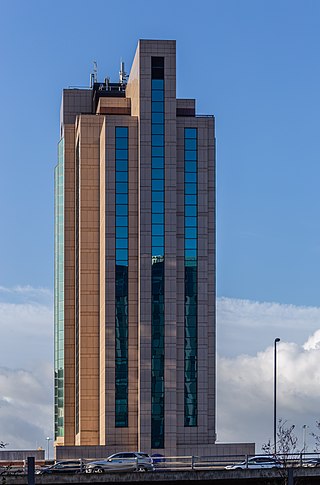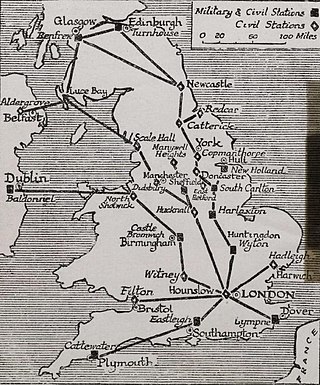Great Cumbrae is the larger of the two islands known as The Cumbraes in the lower Firth of Clyde in western Scotland. The island is sometimes called Millport, after its main town.

Renfrewshire is one of the 32 council areas of Scotland.

Braehead is a commercial development located at the former site of Braehead Power Station in Renfrew on the south bank of the River Clyde in Renfrew, Renfrewshire. It is particularly notable for its large shopping centre, arena and leisure facilities.

Glasgow Airport, also known as Glasgow International Airport formerly Abbotsinch Airport, is an international airport in Scotland. It is located in Paisley, Renfrewshire, 8.6 nautical miles west of Glasgow city centre. In 2019, the airport handled 8.84 million passengers, an 8.4% annual decrease, making it the second-busiest in Scotland, after Edinburgh Airport, and the ninth-busiest airport in the United Kingdom.

Linwood is a town in Renfrewshire in the west central Lowlands of Scotland, 14 miles west of Glasgow. It is about 1+1⁄2 miles northeast of Johnstone and west of Paisley close to the Black Cart Water and the A737 road.

Paisley is a large town situated in the west central Lowlands of Scotland. Located north of the Gleniffer Braes, the town borders the city of Glasgow to the east, and straddles the banks of the White Cart Water, a tributary of the River Clyde.

Dunblane is a town in the council area of Stirling in central Scotland, and inside the historic boundaries of the county of Perthshire. It is a commuter town, with many residents making use of good transport links to much of the Central Belt, including Glasgow and Edinburgh.

Erskine is a town in the council area of Renfrewshire, and historic county of the same name, situated in the West Central Lowlands of Scotland. It lies on the southern bank of the River Clyde, providing the lowest crossing to the north bank of the river at the Erskine Bridge, connecting the town to Old Kilpatrick in West Dunbartonshire. Erskine is a commuter town at the western extent of the Greater Glasgow conurbation, bordering Bishopton to the west and Renfrew, Inchinnan, Paisley and Glasgow Airport to the south. Originally a small village settlement, the town has expanded since the 1960s as the site of development as an overspill town, boosting the population to over 15,000. In 2014, it was rated one of the most attractive postcode areas to live in Scotland.

Inchinnan is a small village in Renfrewshire, Scotland. The village is located on the main A8 road between Renfrew and Greenock, just south east of the town of Erskine.

Shawlands is a Southside suburb of Glasgow, Scotland, located two miles south of the River Clyde. The area, considered the "Heart of the Southside", is known for its independent restaurants and cafés, art scene, public parks, period terraces, and red and blond sandstone tenements. Shawlands was named one of the best places to live in Scotland in 2022 and 2023 by The Sunday Times, and one of the world's coolest neighbourhoods by Time Out Magazine with judges describing it as "the city's best area to live and socialise”. It is located between Pollok Country Park – the home of the Burrell Collection and Pollok House – and the acclaimed Victorian park Queen's Park.

Ladbrokes Coral is a British gambling company founded in 1886. Its product offering includes sports betting, online casino, online poker, and online bingo. The Ladbrokes portion of the group was established in 1886, and Coral in 1926. In November 2016, the companies merged to create Ladbrokes Coral Group. Since March 2018, it has been owned by Entain. Prior to its sale, Ladbrokes Coral was listed on the London Stock Exchange, and was a member of the FTSE 250 Index.

The River Cart is a tributary of the River Clyde, Scotland, which it joins from the west roughly midway between the towns of Erskine and Renfrew and opposite the town of Clydebank.
Sir Reo Stakis was a Cypriot hotel magnate, longtime head of Stakis Hotels.

The Archdiocese of Glasgow is the Latin Catholic metropolitan see of the Province of Glasgow in central Scotland. The episcopal seat of the developing diocese was established by Saint Kentigern in the 6th century AD. It is one of two catholic metropolitan archdioceses of the Catholic Church in Scotland: the only archdioceses in Scotland. It is the elder of the two bishoprics. Innocent VIII first raised Glasgow a metropolitan archbishopric in 1492. The Metropolis has the dioceses of Motherwell and Paisley as suffragans within the Ecclesiastical Province.

The Hilton Glasgow is a 20-story hotel in Glasgow, Scotland. It is located in Anderston, 8 miles from Glasgow Airport, on the edge of the city centre, and close to the M8 Motorway. It opened on 30 November 1992.

Renfrew Airport was the domestic airport serving the city of Glasgow until it was decommissioned in 1966.

The Hilton London Metropole is a 1,100-room 4-star hotel and conference centre located on Edgware Road in central London. It is bounded by the Marylebone Flyover to the north, Praed Street to the south, and the Paddington Basin development to the west.

Renfrew is a town 6 miles (10 km) west of Glasgow in the west central Lowlands of Scotland. It is the historic county town of Renfrewshire. Called the "Cradle of the Royal Stewarts" for its early link with Scotland's former royal house, Renfrew gained royal burgh status in 1397.

The Hilton Birmingham Metropole is the largest hotel in England outside London, with 790 rooms and suites, and approximately 6,000 m2 (65,000 sq ft) of conference halls.

Saint Conval (Conwall) was an Irish-born missionary who, according to legend recorded in the Aberdeen Breviary, as he was praying on the sea shore "to be borne, by whatsoever means, to the regions beyond the sea", was miraculously carried by the stone he stood on across the Irish Sea to Inchinnan in Scotland. He was active in the Kingdom of Strathclyde in the area of East Renfrewshire, where there were “Conval wells” in Barrhead and Thornliebank. He is believed to have founded churches at Inchinnan, Pollokshaws and Fereneze. His bones were preserved in an impressive sarcophagus at the Inchinnan church.





















